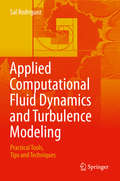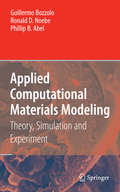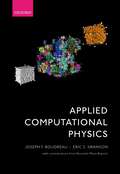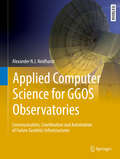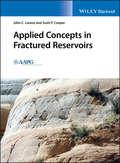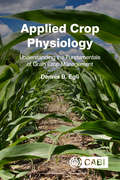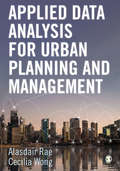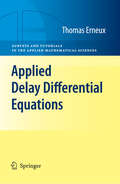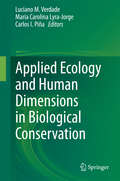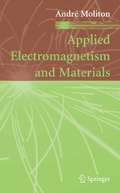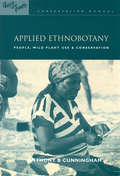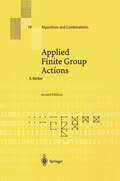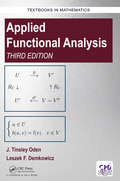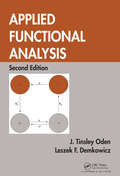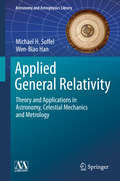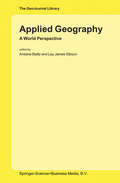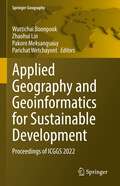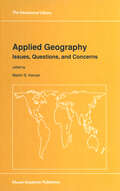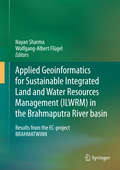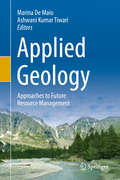- Table View
- List View
Applied Computational Fluid Dynamics and Turbulence Modeling: Practical Tools, Tips and Techniques
by Sal RodriguezThis unique text provides engineering students and practicing professionals with a comprehensive set of practical, hands-on guidelines and dozens of step-by-step examples for performing state-of-the-art, reliable computational fluid dynamics (CFD) and turbulence modeling. Key CFD and turbulence programs are included as well. The text first reviews basic CFD theory, and then details advanced applied theories for estimating turbulence, including new algorithms created by the author. The book gives practical advice on selecting appropriate turbulence models and presents best CFD practices for modeling and generating reliable simulations. The author gathered and developed the book’s hundreds of tips, tricks, and examples over three decades of research and development at three national laboratories and at the University of New Mexico—many in print for the first time in this book. The book also places a strong emphasis on recent CFD and turbulence advancements found in the literature over the past five to 10 years. Readers can apply the author’s advice and insights whether using commercial or national laboratory software such as ANSYS Fluent, STAR-CCM, COMSOL, Flownex, SimScale, OpenFOAM, Fuego, KIVA, BIGHORN, or their own computational tools. Applied Computational Fluid Dynamics and Turbulence Modeling is a practical, complementary companion for academic CFD textbooks and senior project courses in mechanical, civil, chemical, and nuclear engineering; senior undergraduate and graduate CFD and turbulence modeling courses; and for professionals developing commercial and research applications.
Applied Computational Materials Modeling: Theory, Simulation and Experiment
by Guillermo Bozzolo Ronald D. Noebe Phillip B. AbelThe scope of this book is to identify and emphasize the successful link between computational materials modeling as a simulation and design tool and its synergistic application to experimental research and alloy development. The book provides a more balanced perspective of the role that computational modeling can play in every day research and development efforts. Each chapter describes one or more particular computational tool and how they are best used.
Applied Computational Physics
by Joseph F. Boudreau Eric S. SwansonApplied Computational Physics is a graduate-level text stressing three essential elements: advanced programming techniques, numerical analysis, and physics. The goal of the text is to provide students with essential computational skills that they will need in their careers, and to increase the confidence with which they write computer programs designed for their problem domain. The physics problems give them an opportunity to reinforce their programming skills, while the acquired programming skills augment their ability to solve physics problems. The C++ language is used throughout the text. Physics problems include Hamiltonian systems, chaotic systems, percolation, critical phenomena, few-body and multi-body quantum systems, quantum field theory, simulation of radiation transport, and data modeling. The book, the fruit of a collaboration between a theoretical physicist and an experimental physicist, covers a broad range of topics from both viewpoints. Examples, program libraries, and additional documentation can be found at the companion website. Hundreds of original problems reinforce programming skills and increase the ability to solve real-life physics problems at and beyond the graduate level.
Applied Computer Science for GGOS Observatories: Communication, Coordination and Automation of Future Geodetic Infrastructures (Springer Textbooks in Earth Sciences, Geography and Environment)
by Alexander N.J. NeidhardtThis book combines elementary theory from computer science with real-world challenges in global geodetic observation, based on examples from the Geodetic Observatory Wettzell, Germany. It starts with a step-by-step introduction to developing stable and safe scientific software to run successful software projects. The use of software toolboxes is another essential aspect that leads to the application of generative programming. An example is a generative network middleware that simplifies communication. One of the book’s main focuses is on explaining a potential strategy involving autonomous production cells for space geodetic techniques. The complete software design of a satellite laser ranging system is taken as an example. Such automated systems are then combined for global interaction using secure communication tunnels for remote access. The network of radio telescopes is used as a reference. Combined observatories form coordinated multi-agent systems and offer solutions for operational aspects of the Global Geodetic Observing System (GGOS) with regard to “Industry 4.0”.
Applied Concepts in Fractured Reservoirs
by John C. Lorenz Scott P. CooperA much-needed, precise and practical treatment of a key topic in the energy industry and beyond, Applied Concepts in Fractured Reservoirs is an invaluable reference for those in both industry and academia Authored by renowned experts in the field, this book covers the understanding, evaluation, and effects of fractures in reservoirs. It offers a comprehensive yet practical discussion and description of natural fractures, their origins, characteristics, and effects on hydrocarbon reservoirs. It starts by introducing the reader to basic definitions and classifications of fractures and fractured reservoirs. It then provides an outline for fractured-reservoir characterization and analysis, and goes on to introduce the way fractures impact operational activities. Well organized and clearly illustrated throughout, Applied Concepts in Fractured Reservoirs starts with a section on understanding natural fractures. It looks at the different types, their dimensions, and the mechanics of fracturing rock in extension and shear. The next section provides information on measuring and analyzing fractures in reservoirs. It covers: logging core for fractures; taking, measuring, and analyzing fracture data; new core vs. archived core; CT scans; comparing fracture data from outcrops, core, and logs; and more. The last part examines the effects of natural fractures on reservoirs, including: the permeability behavior of individual fractures and fracture systems; fracture volumetrics; effects of fractures on drilling and coring; and the interaction between natural and hydraulic fractures. Teaches readers to understand and evaluate fractures Compiles and synthesizes various concepts and descriptions scattered in literature and synthesizes them with unpublished oil-field observations and data, along with the authors’ own experience Bridges some of the gaps between reservoir engineers and geologists Provides an invaluable reference for geologists and engineers who need to understand naturally fractured reservoirs in order to efficiently extract hydrocarbons Illustrated in full color throughout Companion volume to the Atlas of Natural and Induced Fractures in Core
Applied Concepts in Fractured Reservoirs
by John C. Lorenz Scott P. CooperA much-needed, precise and practical treatment of a key topic in the energy industry and beyond, Applied Concepts in Fractured Reservoirs is an invaluable reference for those in both industry and academia Authored by renowned experts in the field, this book covers the understanding, evaluation, and effects of fractures in reservoirs. It offers a comprehensive yet practical discussion and description of natural fractures, their origins, characteristics, and effects on hydrocarbon reservoirs. It starts by introducing the reader to basic definitions and classifications of fractures and fractured reservoirs. It then provides an outline for fractured-reservoir characterization and analysis, and goes on to introduce the way fractures impact operational activities. Well organized and clearly illustrated throughout, Applied Concepts in Fractured Reservoirs starts with a section on understanding natural fractures. It looks at the different types, their dimensions, and the mechanics of fracturing rock in extension and shear. The next section provides information on measuring and analyzing fractures in reservoirs. It covers: logging core for fractures; taking, measuring, and analyzing fracture data; new core vs. archived core; CT scans; comparing fracture data from outcrops, core, and logs; and more. The last part examines the effects of natural fractures on reservoirs, including: the permeability behavior of individual fractures and fracture systems; fracture volumetrics; effects of fractures on drilling and coring; and the interaction between natural and hydraulic fractures. Teaches readers to understand and evaluate fractures Compiles and synthesizes various concepts and descriptions scattered in literature and synthesizes them with unpublished oil-field observations and data, along with the authors’ own experience Bridges some of the gaps between reservoir engineers and geologists Provides an invaluable reference for geologists and engineers who need to understand naturally fractured reservoirs in order to efficiently extract hydrocarbons Illustrated in full color throughout Companion volume to the Atlas of Natural and Induced Fractures in Core
Applied Crop Physiology: Understanding the Fundamentals of Grain Crop Management
by Dennis EgliThis book presents a simple, straightforward discussion of the principles and processes involved in the production of grain yield by agronomic crops, and how these processes underlie and influence management decisions. The focus is on grain crops, principally maize and soybean, although the general principles apply equally well to cereals, grain legumes and oil crops. Management decisions define all cropping systems - what (crop species, variety), where (climate), when (planting date), and how (row spacing and population density) are the fundamental choices. Knowledge of the fundamental processes responsible for plant growth and the accumulation of yield simplifies the decision-making process and leads to improved management decisions, higher grain yields, and cropping systems that are efficient, resilient and sustainable. The contents include: · Basic plant growth processes e.g. photosynthesis, respiration, evapotranspiration · Growth and production of yield · Crop management - seed quality, variety selection, plant date, row spacing · Crop production in the future - climate change, GMOs, precision data and new crops Intended for researchers in crop science, agronomy and plant science, and crop production practitioners, this book will enable readers to make better, more informed management decisions; decisions that will help maintain a well-fed world in the future.
Applied Data Analysis for Urban Planning and Management
by Cecilia Wong Alasdair RaeThis book showcases the different ways in which contemporary forms of data analysis are being used in urban planning and management. It highlights the emerging possibilities that city-regional governance, technology and data have for better planning and urban management - and discusses how you can apply them to your research. Including perspectives from across the globe, it’s packed with examples of good practice and helps to demystify the process of using big and open data. Learn about different kinds of emergent data sources and how they are processed, visualised and presented. Understand how spatial analysis and GIS are used in city planning. See examples of how contemporary data analytics methods are being applied in a variety of contexts, such as ‘smart’ city management and megacities. Aimed at upper undergraduate and postgraduate students studying spatial analysis and planning, this timely text is the perfect companion to enable you to apply data analytics approaches in your research.
Applied Data Analysis for Urban Planning and Management
by Cecilia Wong Alasdair RaeThis book showcases the different ways in which contemporary forms of data analysis are being used in urban planning and management. It highlights the emerging possibilities that city-regional governance, technology and data have for better planning and urban management - and discusses how you can apply them to your research. Including perspectives from across the globe, it’s packed with examples of good practice and helps to demystify the process of using big and open data. Learn about different kinds of emergent data sources and how they are processed, visualised and presented. Understand how spatial analysis and GIS are used in city planning. See examples of how contemporary data analytics methods are being applied in a variety of contexts, such as ‘smart’ city management and megacities. Aimed at upper undergraduate and postgraduate students studying spatial analysis and planning, this timely text is the perfect companion to enable you to apply data analytics approaches in your research.
Applied Data Analysis for Urban Planning and Management
This book showcases the different ways in which contemporary forms of data analysis are being used in urban planning and management. It highlights the emerging possibilities that city-regional governance, technology and data have for better planning and urban management - and discusses how you can apply them to your research. Including perspectives from across the globe, it’s packed with examples of good practice and helps to demystify the process of using big and open data. Learn about different kinds of emergent data sources and how they are processed, visualised and presented. Understand how spatial analysis and GIS are used in city planning. See examples of how contemporary data analytics methods are being applied in a variety of contexts, such as ‘smart’ city management and megacities. Aimed at upper undergraduate and postgraduate students studying spatial analysis and planning, this timely text is the perfect companion to enable you to apply data analytics approaches in your research.
Applied Delay Differential Equations (Surveys and Tutorials in the Applied Mathematical Sciences #3)
by Thomas ErneuxApplied Delay Differential Equations is a friendly introduction to the fast-growing field of time-delay differential equations. Written to a multi-disciplinary audience, it sets each area of science in his historical context and then guides the reader towards questions of current interest.
Applied Ecology and Human Dimensions in Biological Conservation
by Luciano M. Verdade Maria Carolina Lyra-Jorge Carlos I. PiñaThis book provides both the conceptual basis and technological tools that are necessary to identify and solve problems related to biodiversity governance. The authors discuss intriguing evolutionary questions, which involve the sometimes surprising adaptive capacity of certain organisms to dwell in altered and/or changing environments that apparently lost most of their structure and functionality. Space and time heterogeneities are considered in order to understand the patterns of distribution and abundance of species and the various processes that mold them. The book also discusses at which level—from genes to the landscape, including individuals, populations, communities, and ecosystems—men should intervene in nature in order to prevent the loss of biodiversity.
Applied Electromagnetism and Materials
by André MolitonThis book presents practical and relevant technological information about electromagnetic properties of materials and their applications. It is aimed at senior undergraduate and graduate students in materials science and is the product of many years of teaching basic and applied electromagnetism. Topics range from the spectroscopy and characterization of dielectrics, to non-linear effects, to ion-beam applications in materials.
Applied Ethnobotany: People, Wild Plant Use and Conservation (People and Plants International Conservation)
by Anthony B CunninghamIts wise and sensitive approach to working with local people will be relevant in situations throughout the world.' ECOS 'The numerous diagrams, tables of data, information flow charts, fieldwork sketches etc. give a great vibrancy to the work... It deserves a wide readership.' TEG News Wild or non-cultivated plants are crucial to the lives of a large portion of the world's population, providing low-cost building materials, fuel, food supplements, medicines, tools and sources of income. Despite their importance, their vulnerability to harvesting and other social impacts is not well understood. Applied Ethnobotany is the first practical guide to be published on how to manage wild plant species sustainably. This detailed manual on wild plant resources sets out the approaches and field methods involved in participatory work between conservationists, researchers and the primary resource users. Supported by extensive illustrations, it explains how local people can learn to assess the pressures on plant resources and what steps to take to ensure their continued availability. For all those involved in resource management decisions regarding plant species and diversity, and in particular those studying or working in conservation, rural development and park management, this guide is invaluable. Published with WWF, UNESCO and Royal Botanic Gardens Kew
Applied Ethnobotany: People, Wild Plant Use and Conservation (People and Plants International Conservation)
by Anthony B. CunninghamIts wise and sensitive approach to working with local people will be relevant in situations throughout the world.' ECOS 'The numerous diagrams, tables of data, information flow charts, fieldwork sketches etc. give a great vibrancy to the work... It deserves a wide readership.' TEG News Wild or non-cultivated plants are crucial to the lives of a large portion of the world's population, providing low-cost building materials, fuel, food supplements, medicines, tools and sources of income. Despite their importance, their vulnerability to harvesting and other social impacts is not well understood. Applied Ethnobotany is the first practical guide to be published on how to manage wild plant species sustainably. This detailed manual on wild plant resources sets out the approaches and field methods involved in participatory work between conservationists, researchers and the primary resource users. Supported by extensive illustrations, it explains how local people can learn to assess the pressures on plant resources and what steps to take to ensure their continued availability. For all those involved in resource management decisions regarding plant species and diversity, and in particular those studying or working in conservation, rural development and park management, this guide is invaluable. Published with WWF, UNESCO and Royal Botanic Gardens Kew
Applied Finite Group Actions (Algorithms and Combinatorics #19)
by Adalbert KerberWritten by one of the top experts in the fields of combinatorics and representation theory, this book distinguishes itself from the existing literature by its applications-oriented point of view. The second edition is extended, placing more emphasis on applications to the constructive theory of finite structures. Recent progress in this field, in particular in design and coding theory, is described.
Applied Functional Analysis (Textbooks in Mathematics)
by J. Tinsley Oden Leszek DemkowiczApplied Functional Analysis, Third Edition provides a solid mathematical foundation for the subject. It motivates students to study functional analysis by providing many contemporary applications and examples drawn from mechanics and science. This well-received textbook starts with a thorough introduction to modern mathematics before continuing with detailed coverage of linear algebra, Lebesque measure and integration theory, plus topology with metric spaces. The final two chapters provides readers with an in-depth look at the theory of Banach and Hilbert spaces before concluding with a brief introduction to Spectral Theory. The Third Edition is more accessible and promotes interest and motivation among students to prepare them for studying the mathematical aspects of numerical analysis and the mathematical theory of finite elements.
Applied Functional Analysis (Textbooks In Mathematics Ser.)
by J. Tinsley Oden Leszek DemkowiczThrough numerous illustrative examples and comments, Applied Functional Analysis, Second Edition demonstrates the rigor of logic and systematic, mathematical thinking. It presents the mathematical foundations that lead to classical results in functional analysis. More specifically, the text prepares students to learn the variational theory of parti
Applied Functional Analysis (Textbooks in Mathematics)
by J. Tinsley Oden Leszek DemkowiczApplied Functional Analysis, Third Edition provides a solid mathematical foundation for the subject. It motivates students to study functional analysis by providing many contemporary applications and examples drawn from mechanics and science. This well-received textbook starts with a thorough introduction to modern mathematics before continuing with detailed coverage of linear algebra, Lebesque measure and integration theory, plus topology with metric spaces. The final two chapters provides readers with an in-depth look at the theory of Banach and Hilbert spaces before concluding with a brief introduction to Spectral Theory. The Third Edition is more accessible and promotes interest and motivation among students to prepare them for studying the mathematical aspects of numerical analysis and the mathematical theory of finite elements.
Applied General Relativity: Theory and Applications in Astronomy, Celestial Mechanics and Metrology (Astronomy and Astrophysics Library)
by Michael H. Soffel Wen-Biao HanIn the late 20th and beginning 21st century high-precision astronomy, positioning and metrology strongly rely on general relativity. Supported by exercises and solutions this book offers graduate students and researchers entering those fields a self-contained and exhaustive but accessible treatment of applied general relativity. The book is written in a homogenous (graduate level textbook) style allowing the reader to understand the arguments step by step. It first introduces the mathematical and theoretical foundations of gravity theory and then concentrates on its general relativistic applications: clock rates, clock sychronization, establishment of time scales, astronomical references frames, relativistic astrometry, celestial mechanics and metrology. The authors present up-to-date relativistic models for applied techniques such as Satellite LASER Ranging (SLR), Lunar LASER Ranging (LLR), Globale Navigation Satellite Systems (GNSS), Very Large Baseline Interferometry (VLBI), radar measurements, gyroscopes and pulsar timing. A list of acronyms helps the reader keep an overview and a mathematical appendix provides required functions and terms.
Applied Geography: A World Perspective (GeoJournal Library #77)
by Antoine BaillyApplied Geography, A World Perspective reviews progress in applied geography in different regions of the world. It does this through the eyes of an international panel of highly regarded academic practitioners. The book offers new prospects on the use of established approaches and explores exciting new territories. Together, the contributors provide a comprehensive picture of applied geography today. This book is of relevance to faculty and graduate students in the fields of geography, planning, public policy, regional science and other related social and behavioural sciences.
Applied Geography and Geoinformatics for Sustainable Development: Proceedings of ICGGS 2022 (Springer Geography)
by Wuttichai Boonpook Zhaohui Lin Pakorn Meksangsouy Parichat WetchayontThis volume presents the proceedings of the 2nd International Conference of Geography and Geoinformatics for Sustainable Development (ICGGS), held in Phuket, Thailand, April 7-8, 2022. The collection focuses on the importance of spatial thinking and planning by applying geography concepts and geospatial technology innovations in solving global problems such as environmental degradation, urban pollution, and climate change. The proceedings consist of case studies on wide-ranging spatial issues in developing countries, addressing challenges in mainstreaming sustainable development paradigms into their economies to improve natural resource and environmental management. One of the main goals of the volume is to share and exchange different points of view regarding global, regional, and local spatial issues and how to use geography and geoinformatics for building resilience in multiple sectors, e.g., water, ecosystems, agriculture, and health. It offers the opportunity to learn about how geospatial concepts and technologies can contribute to environmental sustainability, while advancing education and research related to geography and geoinformatics. It will be a useful resource for students and researchers to initiate research ideas related to geospatial topics in regional and local scales.
Applied Geography: Issues, Questions, and Concerns (GeoJournal Library #15)
by Martin S. KenzerThe completion of this collection took many months, and, for a variety of reason, required the assistance and/or indulgence of a number of individuals. First and foremost, I would like to thank Tim Hudson for his useful input and support at the outset of the project Likewise, I would like to thank Jesse O. McKee for providing a hospitable environment during my affiliation with the University of Southern Mississippi. At Louisiana State University I am grateful to Sam Hilliard and Carville Earle for their invaluable understanding. The book became part of the GeoJoumal Library as a result of Wolf Tietze's confidence in the topic, and because of Henri G. van Dorssen's (and Kluwer Academic Publishers') good nab.lre - despite numerous 'problems'. Curtis C. Roseman, and the remainder of the Geography Department at the University of Southern California (where I completed many last minute details for the volume), are to be thanked for the cordial and warm environ ment I received while a visitor in Los Angeles. Finally, no multi-authored collection reaches completion without the help of many patient contributors. This particular book suffered many set-backs along the way, so I am particularly grateful to the authors herein. They demonstrated their compassion and exceptional professionalism throughout, by never second-guessing my decisions, and by allowing me to remedy the set-backs in my own way. They were a pleasure to work with, and they should take pride in their achievements.
Applied Geoinformatics for Sustainable Integrated Land and Water Resources Management (ILWRM) in the Brahmaputra River basin: Results from the EC-project BRAHMATWINN
by Nayan Sharma Wolfgang-Albert FlügelThe central theme of this book is focused on the analyses and the results which emerged from the international research project BRAHMATWINN sponsored by European Commission (EC) and conducted during 2006 – 2009. The book highlights the achievements of BRAHMATWINN to carry out a harmonised integrated water resources management (IWRM) approach as addressed by the European Water Initiative (EWI) in headwater river systems of alpine mountain massifs. The latter are already impacted from climate change, and the BRAHMATWINN project established transfer of professional IWRM expertise, approaches and tools based on case studies carried out in twinning European and Asian river basins. The project addresses all important IWRM issues in a balanced way, including conflict resolution in the trans- boundary Danube and Brahmaputra River Basins in Europe and South Asia respectively.This book will be useful to researchers, professionals, managers and decision makers associated with study and application of sustainable integrated land and water resources management (ILWRM) in the backdrop of climate change.
Applied Geology: Approaches to Future Resource Management
by Marina De Maio Ashwani Kumar TiwariThis book includes a careful selection of significant contributions from international experts that were presented at the 6th AIGA Conference “Applied Geology: Approaches to Future Resource Management” that was held in the Courmayeur, Aosta Valley, Italy, from 27 - 29 June 2018. The following 7 areas are the main themes covered in this volume: · Applied Geology · Hydrogeology · Geological Exploration (underground) · Slope Instability, · Natural Hazards, Risk Assessment and Management, · Geo-resources and Sustainable Development · Application of Remote Sensing and Geographical Information Systems (GIS) The authors, from academia, research and industry present the latest state of the practice, new technologies, innovative methods and sustainable management in the field of Applied and Environmental Geology. This carefully edited work will be of value to academia, professionals, scientists and decision makers.
